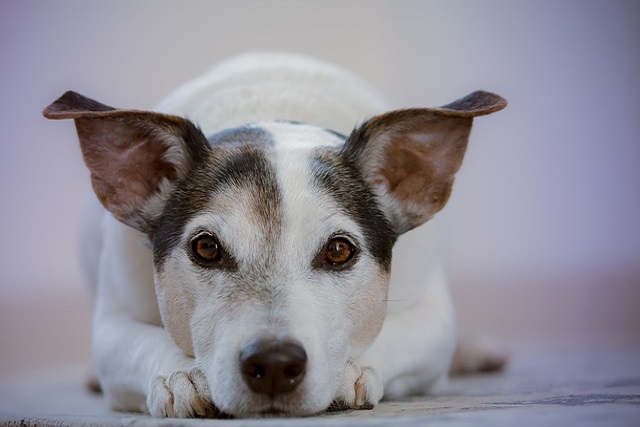
What is glaucoma in a dog?
You might notice your dog squinting more at mealtime or avoiding bright sunlight—these small changes could be early signs of a serious eye condition.
When you close the door behind you and hear your dog's heartbreaking howls, or see through the pet camera how it frantically scratches at the door, that wrenching scene makes every step away feel heavy. A dog's separation anxiety is like invisible shackles, locking away not just their sense of security, but also the constant worry in their owner's heart. Understanding the emotional needs behind this anxiety, and using scientific methods with tender companionship to weave a web of reassurance, can help your furry child learn to wait calmly - turning each separation into a test of trust rather than an ordeal of fear.
First, we must understand that separation anxiety stems from a dog's deep-rooted fear of "owner disappearance." This behavior is essentially an evolutionary survival instinct - lone wolves would howl to call their pack, and pet dogs see their owners as the "alpha." Modern separation anxiety is simply this ancient instinct playing out. Neuroscience shows that anxious dogs have hyperactive amygdala when alone, releasing stress hormones. One Golden Retriever's saliva cortisol levels spiked to 3 times normal when left alone - this isn't "naughty" behavior but genetic "abandonment panic." A rescued stray once broke through glass doors when left alone, its bloody paws showing this wasn't destruction but using pain to fight isolation fear.
"Gradual separation training" is key to rebuilding security, starting with "simulated brief absences." Begin by disappearing from sight for 1 minute at home, rewarding calm behavior; then progress to hiding in the bathroom or stepping outside briefly. One Bichon owner's training diary was moving: Week 1 practiced 5 "1-minute disappearances" daily; Week 2 increased to 3 minutes; by Month 3, the dog could stay calm alone for 30 minutes. Like teaching a child to swim, start in shallow water - throwing them in the deep end only worsens fear. The secret is "making departures and returns mundane." One owner's over-affectionate goodbyes actually reinforced anxiety; later, treating departures as casually as pouring water, paired with treat rewards, helped the dog learn "separations are just brief pauses."

"Environmental adaptation" creates physical and psychological safe zones. Place the bed in a quiet corner away from doors with an owner-scented shirt for security; use white noise machines with rain sounds or classical music to mask triggering noises. One ingenious owner hung a toy mimicking a mother dog's heartbeat above the bed - a puppy weaned too early showed 60% less trembling when alone hearing the rhythmic "thump." For severe cases, "anxiety wraps" work like a gentle hug, using slight pressure to soothe nerves like a reassuring hand on a tense shoulder, helping dogs find comfort in physical containment.
"Strategic use of food and toys" can turn alone time into positive experiences. Give a peanut-butter-stuffed puzzle toy before leaving, letting tasty focus override anxiety; hide treats around the house for sniffing adventures. One Border Collie that destroyed couches from anxiety learned "treasure hunt" games, drastically reducing destruction. Even better is "positive association" - always giving favorite freeze-dried treats when leaving, so "owner departure" means "delicious arrival." After six months, one Labrador would run to its bowl when hearing keys jingle - not forgetting separation pain, but outweighing it with anticipation.
"Quality daily companionship" prevents anxiety long-term. Dogs need "certainty of owner presence" - fixed daily rituals like morning fetch or evening sniff walks create stable expectations. After its owner passed, an elderly woman's Teddy developed severe anxiety until her children instituted regular park walks, restoring calm in three months - routines are anchors in changing tides. "Separation rehearsals" are also vital: even when staying home, frequently mimic putting on coats/jingling keys then immediately returning with rewards. One Poodle became desensitized through this "boy who cried wolf" training.
When your pet camera finally shows peaceful napping instead of anxious pacing, you'll understand: overcoming separation anxiety isn't teaching dogs to accept loneliness, but patiently showing them "absences are temporary; love never leaves." Those training nights, slobbered toys and calming camera records all weave stronger bonds - like the moon knowing the sun will rise, your dog learns each step away brings you closer back. That connection spanning closed doors is love's warmest proof.

You might notice your dog squinting more at mealtime or avoiding bright sunlight—these small changes could be early signs of a serious eye condition.

Let’s set the scene: It’s a sweltering Phoenix afternoon—105°F outside—and you rushed your 2-year-old Lab mix, Cooper, on a quick walk to “get it over with.”

Let’s get real: You’re in your Miami apartment, watching your 3-year-old Corgi, Loki, struggle to climb the stairs to your second-floor unit.

Many dog owners brush off occasional scratching as just “dog behavior,” but persistent itching often signals something more—like a food allergy.

You might first notice your dog scratching more than usual—chewing at their paws until the fur looks thin, or rubbing their face against the couch nonstop.

Let’s be real: You’re standing in your Chicago apartment, watching your 3-year-old Beagle, Max, huff and puff just to climb onto the couch.